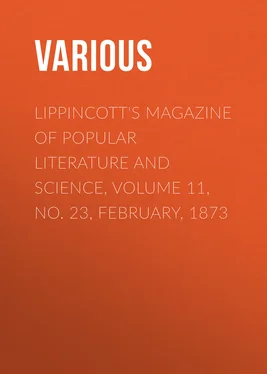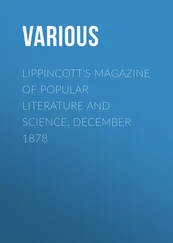Various - Lippincott's Magazine of Popular Literature and Science, Volume 11, No. 23, February, 1873
Здесь есть возможность читать онлайн «Various - Lippincott's Magazine of Popular Literature and Science, Volume 11, No. 23, February, 1873» — ознакомительный отрывок электронной книги совершенно бесплатно, а после прочтения отрывка купить полную версию. В некоторых случаях можно слушать аудио, скачать через торрент в формате fb2 и присутствует краткое содержание. Издательство: Иностранный паблик, Жанр: foreign_antique, periodic, foreign_edu, на английском языке. Описание произведения, (предисловие) а так же отзывы посетителей доступны на портале библиотеки ЛибКат.
- Название:Lippincott's Magazine of Popular Literature and Science, Volume 11, No. 23, February, 1873
- Автор:
- Издательство:Иностранный паблик
- Жанр:
- Год:неизвестен
- ISBN:нет данных
- Рейтинг книги:4 / 5. Голосов: 1
-
Избранное:Добавить в избранное
- Отзывы:
-
Ваша оценка:
- 80
- 1
- 2
- 3
- 4
- 5
Lippincott's Magazine of Popular Literature and Science, Volume 11, No. 23, February, 1873: краткое содержание, описание и аннотация
Предлагаем к чтению аннотацию, описание, краткое содержание или предисловие (зависит от того, что написал сам автор книги «Lippincott's Magazine of Popular Literature and Science, Volume 11, No. 23, February, 1873»). Если вы не нашли необходимую информацию о книге — напишите в комментариях, мы постараемся отыскать её.
Lippincott's Magazine of Popular Literature and Science, Volume 11, No. 23, February, 1873 — читать онлайн ознакомительный отрывок
Ниже представлен текст книги, разбитый по страницам. Система сохранения места последней прочитанной страницы, позволяет с удобством читать онлайн бесплатно книгу «Lippincott's Magazine of Popular Literature and Science, Volume 11, No. 23, February, 1873», без необходимости каждый раз заново искать на чём Вы остановились. Поставьте закладку, и сможете в любой момент перейти на страницу, на которой закончили чтение.
Интервал:
Закладка:
Various
Lippincott's Magazine of Popular Literature and Science, Volume 11, No. 23, February, 1873
SEARCHING FOR THE QUININE-PLANT IN PERU
CONCLUDING PAPER
Early on a brilliant morning, with baggage repacked, and the lessening amount of provisions more firmly strapped on the shoulders of the Indians, the explorers left their pleasant site on the banks of the Maniri. The repose allowed to the bulk of the party during the absence of their Bolivian companions had been wholesome and refreshing. The success of the bark-hunters in their search for cinchonas had cheered all hearts, and the luxurious supper of dried mutton and chuno arranged for them on their return gave a reminiscence of splendor to the thatched hut on the banks of the stream. This edifice, the last of civilized construction they expected to see, had the effect of a home in the wilderness. The bivouac there had been enjoyed with a sentiment of tranquil carelessness. Little did the travelers think that savage eyes had been peeping through the forest upon their fancied security, and that the wild people of the valleys who were to work them all kinds of mischief were upon their track from this station forth.
The enormous fire kindled for breakfast mingled with the stain of sunrise to cast a glow upon their departure. Across the vale of the Cconi, as though a pair of sturdy porters had arisen to celebrate their leavetaking, the cones of Patabamba caught the first rays of the sun and held them aloft like hospitable torches. These huge forms, soldered together at the waist like Chang and Eng, and clothed with shaggy woods up to the top, had been the guardian watchers over their days in the ajoupa at Maniri. The sun just rising empurpled their double cones, while the base and the surrounding landscape were washed with the neutral tints of twilight.
After passing the narrow affluent after which the camping-ground of Maniri was named, the party pursued the course of the Cconi through a more level tract of country. The stones and precipices became more rare, but in revenge the sandy banks soon began to reflect a heat that was hardly bearable. As the implacable sun neared its zenith the party walked with bent heads and blinded eyes, now dashing through great plains of bamboos, now following the hatchets of the peons through thickets of heated shrubbery.
Whenever the country became more wooded in its character, the bark-hunters, whose quest obliged them to stray in short flights around the wings of the column, redoubled their mazes. The careless air of these Bolivian retrievers, their voluntary doublings through the most difficult jungles, and their easy way of walking over everything with their noses in the air, proved well their indifference to the obstacles which were almost insurmountable to the rest.
Nothing could be more singular and interesting than to see them consulting one by one the indications scattered around them, and deciding on their probabilities or promises. Where the height and thickness of the foliage prevented them from seeing the sky, or even the shade of the surrounding green, they walked bent toward the ground, stirring up the rubbish, and choosing among the dead foliage certain leaves, of which they carefully examined the two sides and the stem. When by accident they found themselves near enough to speak to each other—a rare chance, for each peon undertook a separate line of search—they asked their friends, showing the leaves they had found, whether their discoveries appertained to the neighboring trees or whether the wind had brought the pieces from a distance. This kind of investigation, pursued by men who had prowled through forests all their lives, might seem slightly puerile if the reader does not understand that it is often difficult, or even impossible, to recognize the growing tree by its bark, covered as it is from base to branches with parasitic vegetation of every sort. In those forests whatever has a stout stem is used without scruple by the bignonias and air-plants, which race over the trunk, plant their root-claws in the cracks, leap over the whole tree at a single jet, or strangle it with multiplied knots, all the while adorning it with a superb mantle of leaves and blossoms. This is a difficulty which the most experienced cascarilleros are not able to overcome. As an instance, the history is cited of a practico or speculator who led an exploration for these trees in the valley of Apolobamba. After having caused to be felled, barked, measured, dried and trimmed all the cinchonas of one of those natural thickets called manchas —an operation which had occupied four months—he was about to abandon the spot and pursue the exploration elsewhere, when accident led him to discover, in the enormous trunk buried in creepers against which he had built his cabin, a Cinchona nitida , the forefather of all the trees he had stripped.
In this kind of search the caravan pursued the borders of the river, sometimes on this side and sometimes on that, now passing the two-headed mountain Camanti, now sighting the tufted peak of Basiri, now crossing the torrent called the Garote. In the latter, where the dam and hydraulic works of an old Spanish gold-hunter were still visible in a state of ruin, the sacred golden thirst of Colonel Perez once more attacked him. Two or three pins' heads of the insane metal were actually unearthed by the colonel and displayed in a pie-dish; but the business of the party was one which made even the finding of gold insignificant, and they pursued their way.
The flanks of these mountains, however, were really of importance to the botanical motive of the expedition. Along the side of the Camanti, where the yellow Garote leaked downward in a rocky ravine, the Bolivians were again successful. They brought to Marcoy specimens of half a dozen cinchonas, for him to sketch, analyze and decorate with Latin names. The colors of two or three of these barks promised well, but the pearl of the collection was a specimen of the genuine Calisaya , with its silver-gray envelope and leaf ribbed with carmine. This proud discovery was a boon for science and for commerce. It threw a new light upon the geographical locality of the most precious species of cinchona. It was incontestably the plant, and the Bolivians appeared amazed rather than pleased to have discovered outside of their own country a kind of bark proper only to Bolivia, and hardly known to overpass the northern extremity of the valley of Apolobamba. This discovery would rehabilitate, in the European market, the quinine-plants of Lower Peru, heretofore considered as inferior to those of Upper Peru and Bolivia. The latter country has for some time secured the most favorable reputation for its barks—a reputation ably sustained by the efforts of the company De la Paz, to whom the government has long granted a monopoly. This reputation is based on the abundance in that country of two species, the Cinchona calisaya and Boliviana, the best known and most valued in the market. But for two valuable cinchonas possessed by Bolivia, Peru can show twenty, many of them excellent in quality, and awaiting only the enterprise of the government and the natural exhaustion of the forests to the south.
This magnificent bit of luck, the finding of the calisaya, awakened in the susceptible bosom of Mr. Marcoy an ardent desire to explore for himself the site of its discovery. But Eusebio, the chief of the cascarilleros, assuming a mysterious and warning expression, informed the traveler that the place was quite inaccessible for a white man, and that he had risked his own neck a score of times in descending the ravine which separated the route from the hillside where the fortunate plants were growing. He promised, however, to point out the locality from afar, and to show, by a certain changeable gloss proper to the leaf, the precise stratum of the calisaya amongst the belts of the forest. This promise he forgot to execute more particularly, but it appeared that the locality would never be excessively hard to find, marked as it was by Nature with the gigantic finger-post of Mount Camanti. Placing, then, in security these precious specimens among their baggage, the explorers continued their advance along the valley.
Читать дальшеИнтервал:
Закладка:
Похожие книги на «Lippincott's Magazine of Popular Literature and Science, Volume 11, No. 23, February, 1873»
Представляем Вашему вниманию похожие книги на «Lippincott's Magazine of Popular Literature and Science, Volume 11, No. 23, February, 1873» списком для выбора. Мы отобрали схожую по названию и смыслу литературу в надежде предоставить читателям больше вариантов отыскать новые, интересные, ещё непрочитанные произведения.
Обсуждение, отзывы о книге «Lippincott's Magazine of Popular Literature and Science, Volume 11, No. 23, February, 1873» и просто собственные мнения читателей. Оставьте ваши комментарии, напишите, что Вы думаете о произведении, его смысле или главных героях. Укажите что конкретно понравилось, а что нет, и почему Вы так считаете.












